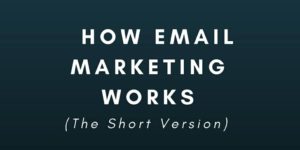 I received an email from a Digital Media Minute reader in response to a recent post on Internet marketing newsletters I recommend subscribing to, where I listed nine newsletters that have helped me a lot over the years.
I received an email from a Digital Media Minute reader in response to a recent post on Internet marketing newsletters I recommend subscribing to, where I listed nine newsletters that have helped me a lot over the years.
The reader complained that I’d pointed to these examples of great newsletters without really explaining how email marketing works and why it’s effective, also saying that he thought people were getting more than enough email as it is.
I thought I’d take a minute to quickly go over the thought process behind email marketing, just the basics and why it makes sense for both marketers and their subscribers.
So when marketing with email newsletters, here’s the basic rallying cry for marketers:
Give as much value as you can to the subscribers on your email list.
That doesn’t mean give value only after your readers have subscribed.
It really starts with the content marketing you’re doing on your website, publishing content Google deems worthy enough to send people to.
Content that gets readers’ attention and eventually has them recognizing you as an authority.
This helps you as a marketer in your efforts to get readers to trade their email address for a ‘lead magnet’ from you.
A lead magnet is a piece of quality content that will teach something related to the reason your readers came to your site in the first place. An ‘ethical bribe’, it could be a pdf or an infographic, free entrance to a webinar, or even a short course on a topic, delivered by–you guessed it–email.
With both your website articles/blog posts and your lead magnet, your goal is to educate and delight with the quality of the content you provide. It’s critical that your new subscribers associate your content with being valuable.
It will have them paying attention and opening those critical first emails you send them.
The first newsletters you send should create a small habit in them to look forward to what you send for the value it contains. It will also help to keep your emails out of their spam folder.
After this, you send out regular emails, always providing value. What about making money? Some marketers sell every once in a while to their subscribers, some sell on every single email (as we all know).
This is critical: do surveys and track email clicks to understand the people on your list, segment them based on those interests, and market to them accordingly.
This little dance to grow and sell to your list is still**very**effective in 2017, especially when done with care.
If you have a website, no matter if you are business or a blogger, even if you don’t yet know what you’ll sell your list, you should be making one. Sumo.com has excellent free tools to help you get started.
Even as a blogger with no thoughts yet of monetizing your efforts, your subscribers might become customers for digital products you create, or prospective clients for a marketing agency you might start.
No matter what you’re doing, there’s no reason not to attempt a communications channel for the 95+% of people who come to your site and never come back.
They say ‘the money is in the list’, and it’s one of those adages that’s still hard to argue with.
For many people, collecting email addresses begins their transition from ‘blogger’ to online marketer.